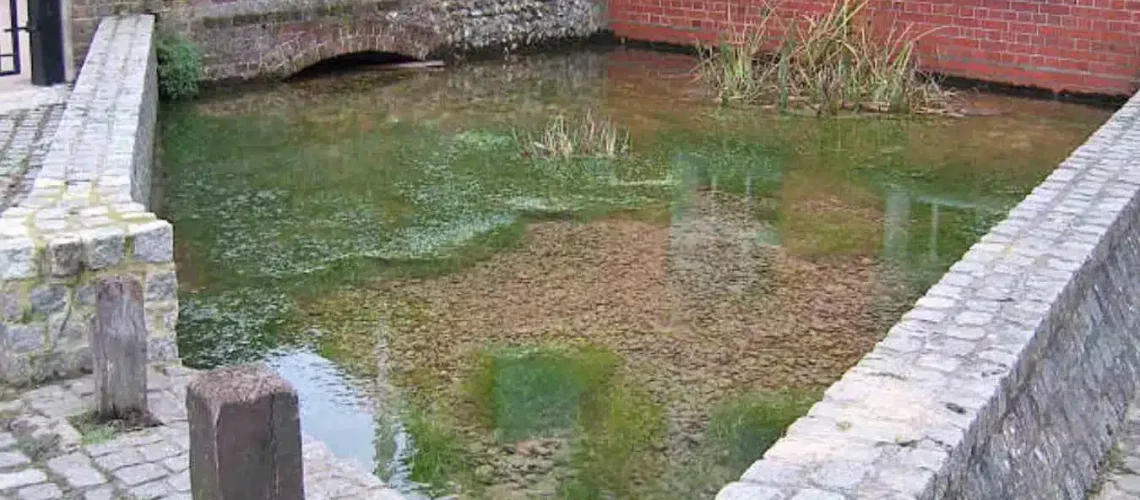To walk Havant consciously is to walk upon layers of devotion — Celtic, Roman, medieval, and modern. To stand by the Homewell spring is to stand at the same threshold where countless women once came to bless their children, gather water for ritual, or whisper their secrets to the earth. And to listen to these waters now is to remember that the sacred has always been here — quietly flowing beneath the noise, waiting for us to return.

Beneath Our Feet, She Flows: The Sacred Waters of Havant
This piece revisits themes from my earlier blog Havant’s Hidden Magic: Embrace the Sacred Flow — a few years on, my relationship with this land and its waters has deepened, and new threads have emerged.
A Land Held by Water
Even though I wasn’t born here, Havant has always felt alive — a place humming with the quiet pulse of the unseen. Beneath its streets and gardens runs a network of more than twenty ancient springs, feeding the land with a steady, crystalline flow.
The name Hamafunta — first recorded in AD 935 — literally means Hama’s spring. Water is the womb of this place. The Homewell spring, near St Faith’s churchyard, still rises clear and constant at 51°F, whispering stories of healing and devotion from an older world that recognised the sanctity of the source.
Where Water Speaks of the Feminine
Across cultures, springs were portals of the goddess. In the Celtic and Romano-British world, water was never merely water — it was living presence. Havant’s wells would have been natural shrines to the feminine aspect of divinity: the flow, the receptivity, the renewal.
The Romans honoured this current too. Just a few miles west in Chichester (Noviomagus Reginorum), an inscription from the first century AD dedicates a temple to Neptune and Minerva — the god of waters and the goddess of wisdom and craft. This pairing hints at the sacred balance between intuition and intellect, flow and form — the same dance we feel in the springs that birth Havant’s story.
Could the water goddess of Havant have been seen as a local face of Minerva — or of an older Celtic well-spirit the Romans simply renamed? We can’t know for sure, but the resonance is there. The feminine current runs strong through both.
The Offerings of the Deep
Roman traces ripple beneath Havant’s soil. Archaeologists have unearthed coins and a bronze ring engraved with Neptune — god of rivers and springs — from an ancient well here, along with eight carefully placed dog skeletons.
In Roman-Celtic ritual, dogs were sacred guardians of thresholds, companions of healing gods, and psychopomps between worlds. Their burial in the water may have been a devotional act — an offering to ensure the vitality of the source, a prayer for renewal.
Beneath our feet, Havant carries this same memory of offering, of reverence, of exchange between human and element.
Oysters, Tides & the Sacred Marriage
Down at Langstone Harbour, the remnants of the oyster beds glisten like moonscales. Oysters — dwellers of brackish thresholds — symbolise the marriage of sea and shore, masculine strength and feminine receptivity. In Celtic lore they represented fertility, abundance, and new beginnings. They remind us that creation happens where opposites meet — salt and sweet, land and water, sun and moon.
Ley Lines & Living Currents
Havant rests along a ley line that threads from Hayling Island through Clanfield, linking the coastline’s watery altars with the downs’ dry bones. Whether one sees these lines as metaphysical energy or poetic geography, they mark the living current that has always run through this land — connecting temples, wells, churches, and hearts.
A Modern Invocation
If you’re drawn to experience the energy of this land in person, my work at The Alchemist Retreat in Havant continues this lineage of water, wisdom, and reclamation.
